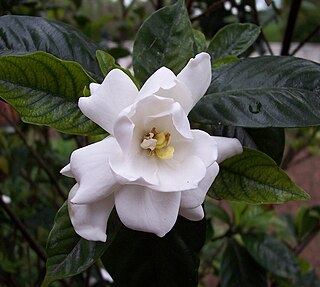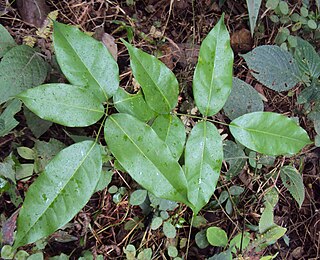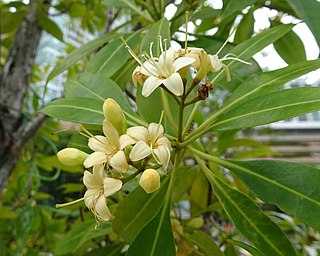
Uncaria is a genus of flowering plants in the family Rubiaceae. It has about 40 species. Their distribution is pantropical, with most species native to tropical Asia, three from Africa and the Mediterranean and two from the neotropics. They are known colloquially as gambier, cat's claw or uña de gato. The latter two names are shared with several other plants. The type species for the genus is Uncaria guianensis.

Gardenia is a genus of flowering plants in the coffee family, Rubiaceae, native to the tropical and subtropical regions of Africa, Asia, Madagascar, Pacific Islands, and Australia.

Gentianaceae is a family of flowering plants of 103 genera and about 1600 species.

Canarium is a genus of about 100 species of tropical and subtropical trees, in the family Burseraceae. They grow naturally across tropical Africa, south and southeast Asia, Indochina, Malesia, Australia and western Pacific Islands; including from southern Nigeria east to Madagascar, Mauritius, Sri Lanka and India; from Burma, Malaysia and Thailand through the Malay Peninsula and Vietnam to south China, Taiwan and the Philippines; through Borneo, Indonesia, Timor and New Guinea, through to the Solomon Islands, Vanuatu, New Caledonia, Fiji, Samoa, Tonga and Palau.

Cissus is a genus of approximately 350 species of lianas in the grape family (Vitaceae). They have a cosmopolitan distribution, though the majority are to be found in the tropics.

Litsea is a genus of evergreen or deciduous trees or shrubs belonging to the laurel family, Lauraceae. The genus includes a large number of accepted species in tropical and subtropical areas of North America and Asia.

Dillenia is a genus of flowering evergreen or semi-evergreen trees and shrubs in the family Dilleniaceae, native to tropical and subtropical regions of southern Asia, Australasia, and the Indian Ocean islands.

Tetrastigma is a genus of plants in the grape family, Vitaceae. The plants are lianas that climb with tendrils and have palmately compound leaves. Plants are dioecious, with separate male and female plants; female flowers are characterized by their four-lobed stigmas. The species are found in subtropical and tropical regions of Asia, Malaysia, and Australia, where they grow in primary rainforest, gallery forest and monsoon forest and moister woodland. Species of this genus are notable as being the sole hosts of parasitic plants in the family Rafflesiaceae, one of which, Rafflesia arnoldii, produces the largest single flower in the world. Tetrastigma is the donor species for horizontal gene transfer to Sapria and Rafflesia due to multiple gene theft events.

The genus Cayratia consists of species of vine plants, typical of the tribe Cayratieae. Some of them are useful, and they are found in tropical and subtropical areas of Asia, Africa, Australia, and islands of the Pacific Ocean.

Lasianthus is a genus of flowering plants in the family Rubiaceae. They are tropical subshrubs, shrubs, or rarely, small trees. They inhabit the understory of primary forests.

Aidia is a genus of flowering plants in the family Rubiaceae. It was described by João de Loureiro in 1790. It has a wide distribution area and occurs in tropical Africa, tropical and subtropical Asia and the western Pacific.

Connarus is a genus of plants in the family Connaraceae.

Gynochthodes is a genus of flowering plants in the family Rubiaceae. The genus is found from Madagascar to tropical and subtropical Asia and the Pacific region.

Rourea is a genus of plants in the family Connaraceae. They are found worldwide across the tropics and subtropics.

Cyrtophyllum is a genus of tropical Asian tree species in the family Gentianaceae and the tribe Potalieae. Species may have previously been placed in the genus Fagraea and can be found in Indo-China and Malesia.
Utania is a genus of flowering plants belonging to the gentian family (Gentianaceae), the tribe Potalieae, and the subtribe Potaliinae. A small genus it has 12 species.


















